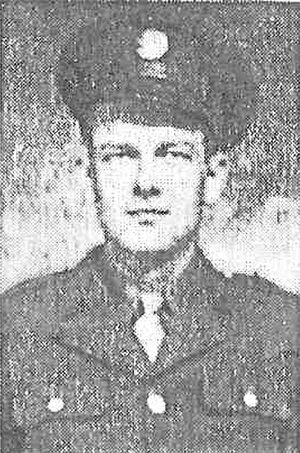
January 29, 1945

Remember...
Kermit Delmer Oxley
1920-1944
"How great the loss when one so loved is taken . . ."
Inscription on the headstone for Kermit D. Oxley
 January 29, 1945 |
Remember...Kermit Delmer Oxley
|
Kermit Delmer Oxley was born at Yawkey, Lincoln County, West Virginia, on February 7, 1920, to Homer Franklin and Etter Mary Elkins Oxley. The 1940 Federal Census shows the family to be living in Sherman, Boone County, with their son Kermit. An older brother, Don Cisco Oxley, had died in 1939. The census taker recorded that Kermit attended school in Boone County with seventh grade being the highest completed. Prior to entering the service, Kermit married Eva F. Cooper, and they had a son, Darl Delmer Oxley. In civilian life, Kermit Oxley was employed by the Pure Oil Company, according to a newspaper account.
Kermit D. Oxley signed up for the draft when he was 21 years old. Registering at St. Albans, he stated that he was living in Spring Hill, West Virginia, was employed by J. H. McGrew and Company, and his father would always know his address. Though no date is listed on his draft card, his registration would have taken place in approximately 1941. Etter Mary Oxley died in 1942.
Other than the fact that he had married Eva and had a son Darl, little is known of the life of Kermit Oxley in the early 1940s. Newspaper accounts of his death show that Kermit had been assigned to the U.S. Army Medical Corps and was a member of a hospitalization unit by the fall of 1944. On November 25, 1944, ten months after he entered the service, he was killed in action in Germany during the Battle of Huertgen Forest.
John Greenwood, Ph.D., Chief, Office of Medical History, Office of the Surgeon General, U.S. Army/Headquarters, U.S. Army Medical Command, writing in 2007, offers a comprehensive account of the Battle of Huertgen Forest:
The U.S. Army's fight to take the Huertgen Forest stretched from September into December 1944 when the German Ardennes offensive disrupted the entire Allied front. During these months, the battles of the V and VII Corps of the First U.S. Army became one of the most costly and controversial American operations of the entire European war. Eventually, the 1st, 4th, 8th, 9th, and 28th Infantry Divisions, 2d Ranger Battalion, and 46th Armored Infantry Battalion and Combat Command R, 5th Armored Division, were all heavily engaged in the fighting. The 9th Infantry Division was involved twice, once in September and then again in October, and its 47th Infantry Regiment was actually engaged three separate times. During its operations in early November in the area of Vossenack, Kommerscheidt, and Schmidt, known collectively as the battle of Schmidt, the 28th Infantry Division lost more men in the forest than any of the other divisions. The divisions suffered over 30,000 casualties in killed, wounded, missing in action, combat exhaustion, and to various disease and non-battle injuries.
Greenwood notes the following contributions of the Medical Service in the European Theater of Operations from September through December of 1944:
By the time that American forces reached the German border in the First U.S. Army's area of operations in September 1944, the Medical Service of the European Theater of Operations (ETOUSA) and the 6th and 12th U.S. Army Groups (First, Third, Seventh, and Ninth U.S. Armies) was functioning smoothly and daily handling thousands of sick and wounded soldiers. Front line medical support in the airborne, armored, and infantry divisions was providing life-saving medical care under fire, while the chain of evacuation operated efficiently to move the casualties from the divisions to rear area hospitals in the Communications Zone for care. "Hard Fighting at the West Wall," an excerpt from the official history of the U.S. Army Medical Department in World War II, The Medical Service in the European Theater, covers the period of stalemate along the German border from mid-September through the onset of the German Ardennes offensive in mid-December and provides the Medical Service context for combat operations from Holland to the Swiss border. ("The Fight for Huertgen Forest," U.S. Army Medical Department, Office of Medical History, 7 March 2007, accessed 28 January 2021, https://history.amedd.army.mil/booksdocs/wwii/HuertgenForest/HF.htm.)
Article prepared by Patricia Richards McClure
January 2021

West Virginia Archives and History welcomes any additional information that can be provided about these veterans, including photographs, family names, letters and other relevant personal history.